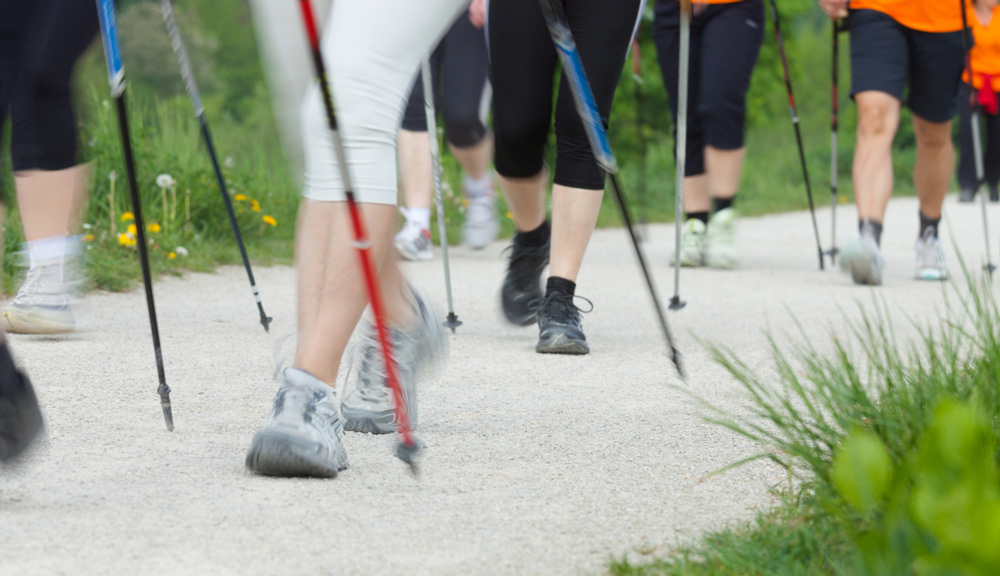
All exercise is good, and some is better than none, but the health benefits of Nordic walking are superior, study finds.
Cardiovascular rehab programs and exercise in general is known to improve the health of people with heart disease. However, less is known about whether such improvements are sustained after a program ends. That is, until now.
Researchers comparing the sustained effects of cardiovascular rehab exercises in patients with coronary artery disease have determined Nordic walking confers additional health benefits.
“Statistically and clinically superior”
Dr. Jennifer Reed is the director of the Exercise Physiology and Cardiovascular Health Laboratory at the University of Ottawa Heart Institute (UOHI), and the recent author of a study that found Nordic walking is “statistically and clinically superior” to high-intensity interval training (HIIT) and moderate-to-vigorous intensity continuous training (MICT) in increasing functional capacity in patients with coronary artery disease enrolled in cardiac rehabilitation.

Tasuku Terada, a postdoctoral fellow under Dr. Reed’s supervision at the UOHI, has since published a second, follow-up study with similar findings, only focusing on the sustainability of the exercise’s effects over time.
When compared directly, HIIT, MICT and Nordic walking have similar prolonged effects on disease-specific and general quality of life and depression symptoms. Yet, for increasing functional capacity, the prolonged effects of Nordic walking are, again, superior.
Functional capacity refers to a person’s ability to perform physical tasks and is an important predictor of future cardiovascular events.
“Our research is novel in that it is the first to simultaneously compare the sustained effects of different exercise programs that can readily be incorporated into daily exercise. Our findings can impact patient care by providing alternative exercise options based on their interests and needs.”
- Tasuku Terada, postdoctoral fellow, UOHI
“Patient preference should be considered”
If getting active is the closest thing to a magic pill for good health, then healthcare professionals may prescribe Nordic walking to people with coronary artery disease. However, despite their findings, both Terada and Reed maintain that “Any exercise is good, and some exercise is better than none.”

While patients are encouraged to maintain an active lifestyle following the completion of exercise-based cardiovascular rehab, adherence to structured exercise remains low, and physical activity engagement decreases significantly in the year after programming ends.
“We want to see more patients adhering to cardiovascular rehab and incorporating physical activity as part of an everyday exercise regime,” said Terada. “Getting active is the single most effective tool a person can use to improve their overall health.”
When prescribing exercise for cardiovascular rehabilitation, Terada, Reed et al. conclude: “Patient preference should be considered.”
So, what is Nordic walking, anyway?
Nordic walking is a “total-body” version of conventional walking. It is performed with the use of walking poles similar to ski poles.

The exercise recruits core, upper and lower body muscles while reducing loading stress at the knee, which, Terada said, may explain why it resulted in greater improvements in functional capacity in study participants.
Nordic walkers consume more oxygen, burn more calories, and have a quicker heart rate response than conventional walking.

Nordic walking is a low impact exercise suitable for people of any age and all fitness levels. It can be performed on any walkable surface and in any climate, making it a versatile physical activity for any time of year.
Thanks to our donors and grant agencies for making this research possible
The authors acknowledge support received from the Innovation Fund of the Alternate Funding Plan for the Academic Health Sciences Centres of the Ontario Ministry of Health; Heart and Stroke Foundation of Canada; and the Canadian Institutes of Health Research postdoctoral fellowship, as well as the Jan & Ian Craig Cardiac Prevention and Rehabilitation endowed fellowship from the University of Ottawa Heart Institute.
Never miss a Beat
Want interesting stories like this delivered straight to your inbox as they happen? Subscribe to our mailing list.

